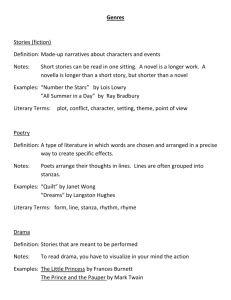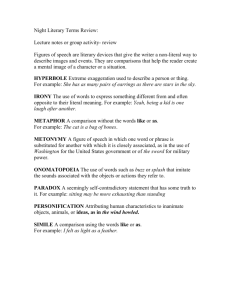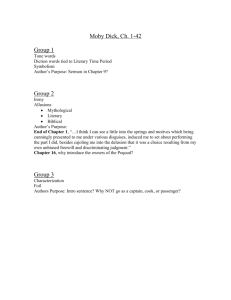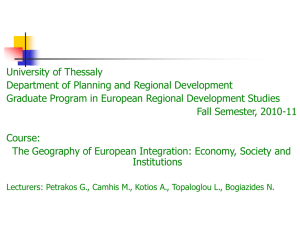The Grand Tour and Travel Writing
advertisement
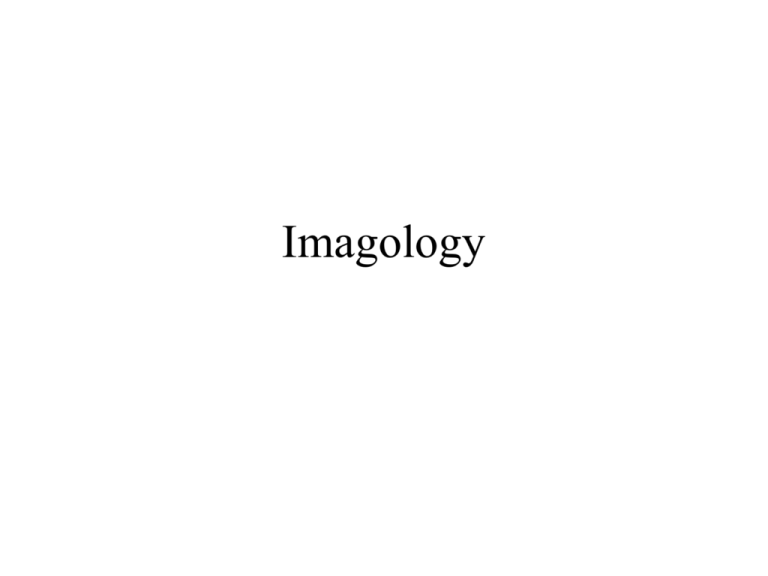
Imagology Imagology • Study of images of (supposedly) national character in literature. Not what the Other is but how s/he is perceived and represented. • Sees national images as “intrinsic” to a text’s inner fabric, permeating its very substance (Dyserinck 1967, 1982). • Deconstruction of the rhetoric of national characteristics. – Analyse how and why it was constructed The issue of Otherness (Alterity) – Closely linked to the debate Alterity / Identity – People external to one’s society are naturally perceived as Other in terms of language, mores, religion or physical characteristics. • Stereotypes,clichés, ethnic prejudices • Essentialism • Determinism – Self / Other dialectic at the core of the debate on alterity. “Imagined Communities” • The Other is endowed with “a specific set of characterizations and attributes” which cannot be tested empirically and, therefore, are ”imaginated” (Leersen) • Generally, imaginated discourse [ – a] singles out a nation from the rest of humanity as being somehow different or ‘typical’, – [b] articulates or suggests a characterological, collective-psychological motivation for given social or national features. Study of Otherness • A developing field in comparative literature and cultural studies • Falls under the labels of imagology or semiotic theory of culture, literary geopolitics, cultural geography. • de Certeau calls it “Ethno-graphy” . The representation of the Other as inferior • Imagology is closely linked to the study of the racial, gendered, or ethnic Other, in other words to the way “a hegemonic culture or gender group views different and subaltern ones as exotic or inferior or just plain alien (Miller 1). Identity • Identity too is constructed and not a transcendent-essentialist notion. • Often based on binary oppositions, characteristics belonging to one’s own culture are opposed to those belonging to the “other” culture, • one’s own characteristics are idealized • those of the Other are denigrated. Self-definition • One defines one’s own culture by defining other cultures in the same way as “the self defines itself by defining the other … Each description or definition of the other culture implies a self-description or selfdefinition”(Pfister 4) • Stephen Greenblatt calls this process “selffashioning”. Constructedness of Nationality e.g. National Identity • What came first, Nation or Nationalism? • Notion of nationality has no ontologically autonomous existence. There is no nationality per se. – Case of Italy. An abstraction. (indicates neither a state nor a nation). Gioberti: “popolo italiano non esiste, è un presupposto) Existed only in literature and thanks to it. Literature promotes it Field for imagological studies • Exists because it has been articulated – Literature, because it manifests and documents the nation’s identity (V. Italian lit.) – Travel literature – Culture (cinema, TV, cartoons) • National stereotypes are first and most effectively formulated, perpetuated and disseminated by imaginary literature. • Nationality “ “Identity” “Alterity” are literary tropes (Guyard, L’étranger tel qu’on le voit, 1954) Imagology a meta-discursive practice • Study of literary representation of foreign cultures and nationalities . • Study of national and ethnic stereotype in literature. • Discourse analysis. Imagology is concerned with representations as textual strategies. • What has been written about him/her. What Imagology is not • Its aim is not to understand the society or culture of another country. • Not sociology nor even “literary sociology” (Wellek) • Not anthropology. • Not collective opinion but a summa of subjectivities. Not an objective representation • Not what the Other is but how s/he is perceived and represented. What has been written about him/her. • The image is a textual construct. No question of its validity or objectivity. • Not making the difference, i.e. Considering difference an objective datum, has let to persecutions, podroms, colonialism, Hitler) Subjectivity in the construction of the Other • Subjectivity must be taken into account in the analysis of representations of the Other. • The nationality represented is silhouetted in the perspectival context of the representing text or discourse. • Dynamics between those images which characterize the Other (hetero-images) and those which characterize one’s own, domestic identity (self-images or autoimages). Genres • Fiction. Often concerned with encounter with Other whether at home or abroad. • Travel literature and literary works engaging with questions of travel – Michel de Certeau: “Every story is a travel story, a spatial practice” – Fictional accounts (but all representations are fundamentally fictional) • So-called truthful travel account, are also based on construction of delf and other. • Drama (V. Shakespeare); Poetry The question of Otherness (or Alterity) in Travel Literature • Most travel writing - whether part of an anthropological, sociological, semiological or literary project - is concerned with the encounter with Otherness either directly or through signs. • Terms of a discourse on Otherness were established in descriptions of the natives in countries “discovered” by the Western world (seeTodorov, Fanon) Emergence of travel writing as a focus for study • Dismissed in the past as a ‘subliterary’ genre. – At best considered as an historical archive . • Travel writing has emerged in recent years as a focus for study and research across a whole range of disciplines. • Now being studied in terms of its history, formal characteristics, and problems of representation, and for what it can be made to say about a whole range of themes Reasons for the resurgence of interest in travel writing • Cultural studies. (cf. Raymond Williams). • Discourse analysis, or rhetorical analysis: • a suspicious close reading • deconstructing the text • decoding of imperialist rhetoric and its key tropes. • Anthropology, Ethnography. Were the first to show interest in Otherness – Representations of identity and difference. – Discourse of the Other • Colonialism, Postcolonialism. (cf. Todorov) • Multidisciplinary studies. Effects of travel studies • Increase in understanding of and interactions with the rest of the world. • Change in how others have perceived and understood other places, cultures and societies. Self.consciousness about stereotyping. • Inputs about a whole range of themes – history, geography, society, art – identity and difference; – Gender and Power, Travel and Otherness • Travel literature mostly focuses on different people and countries and on how certain characteristics, functions, and qualities are assigned to them. • Ideological bias behind national stereotypes (See Edward Said’s Orientalism (1978). • Ideas of difference, strangeness, exoticism, lack of civilisation do not only apply to far off countries (e.g. The East) but also to places nearby (Ireland, Italy) Conventions about the representation of the Other • Stigmatisation of a foreigner or someone who is different from oneself as a way of defining and securing one’s own positive identity through comparison. • Ignoring or demeaning the artistic and literary manifestation of the Other and imposing one’s language and one’s own literary and artistic canons are all forms of discrimination. • The Othering process may take subtler avenues and work out through language. – e.g. stereotyping, the use of clichés, metaphors. Conventions continued • Inexpressibility; can only be represented by inversions “no longer a matter of a and b, simply of a and the converse of a. ( Hartog, The Mirror of Herodotus). • Binary oppositions, whereby characteristics belonging to one’s own culture are opposed to those appertaining to the “other” culture, in such a way that one’s own characteristics are idealized and those of the Other are denigrated. Some important theorists – Edward Said,Orientalism, (1978) a seminal work that has transformed the study of culture and cultures. It uncovers the ideological bias behind national representations (primarily concerned the East and colonized countries., but applicable to other countries as well) – Yuri M. Lotman Universe of the Mind: A Semiotic Theory of Culture (1990). – Michel de Certeau, creates a historical psychology of alterity. – Joep Leersen, Raymond Corbey, Manfred Beller. – Hayden White: Tropics of Discourse (1984): a milestone in modelling and theorising non-fictional representation of the Other. – New Historicists (Greenblatt, Montrose) study documents related to travel and conquest as if they were literary texts. Questions for discussion • How have literary texts expressed, or propagandized identity? • How are is the image of the other used to exorcise certain undesirable traits of the self? • How is otherness confronted or assimilated • What is the role of the Other in forming identity?






